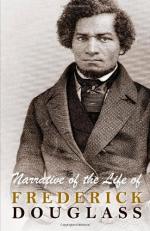|
|
The Narrative of the Life of Frederick Douglass Topic Tracking: Dehumanization
Chapter 1
Dehumanization 1: Douglass points out that slaveholders have cunningly established as law the designation of the children of slave women to follow the condition of their mothers so as to legally protect themselves from becoming their fathers. This law gives them free reign to act upon their lusts. Slave women are helpless victims of their white master's lusts. The other victims are the mulatto children who are severely mistreated, especially by their white mistresses because they represent their husband's infidelity. Mulatto children are most often sold off by their own fathers.
Dehumanization 2: When Douglass is a young boy, he witnesses for the first time a slave getting whipped. It is his Aunt Hester, who is stripped to her waist, put up on a hook, and whipped till she is bloodied. Douglass hides in a closet, thinking that he would be the next victim. This is Douglass's first encounter with the extreme cruelty of slaveholders.
Chapter 4
Dehumanization 3: In Talbot county, killing a slave is often not considered a criminal offense. Slaveholders have little regard for their slaves' lives. Douglass recounts several murders where the perpetrator receives little or no punishment. There are many murders that go unpunished. There is a common saying among the white little boys that it is worth a half-cent to kill a slave and a half-cent to bury one.
Chapter 5
Dehumanization 4: On the Great House Farm, young Douglass suffers from constant hunger and cold. He has to steal a corn bag so that he can keep warm sleeping on the cold, damp floors. Slave children go half-naked all year long and are fed food in a trough like pigs.
Chapter 6
Dehumanization 5: Not only is slavery dehumanizing for the slaves, but for the slaveholders as well. Douglass presents the case of Mrs. Sophia Auld. Before becoming a slaveholder, she is pure, kind, and full of generosity. After becoming a slaveholder, there is an obvious transformation in her disposition. The menacing effects of slavery rob her of all her good qualities.
Chapter 8
Dehumanization 6: After the death of Captain Anthony, Douglass goes back to Talbot county to be evaluated as property to be divided between Mrs. Lucretia and Master Andrew. All the slaves are ranked along with the animals. Slaves are forced to abandon friends, family, and familiar ties on the whims of the white slaveholders.
Chapter 10
Dehumanization 7: Douglass is sent to work for Mr. Covey, a man known to break unruly slaves. Douglass considers the first six months working for Mr. Covey the darkest time of his life. He is overworked and constantly beaten. Douglass hits a low point in his life when he no longer wishes to read, think, or even live. He describes himself as having been transformed from a man into a brute.




